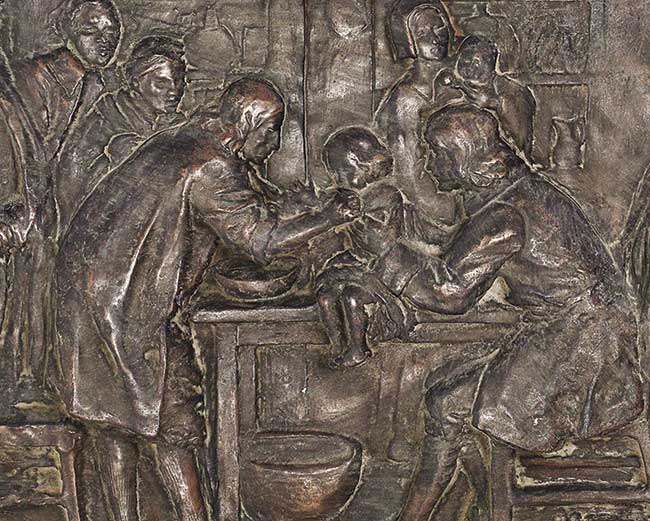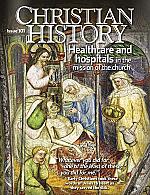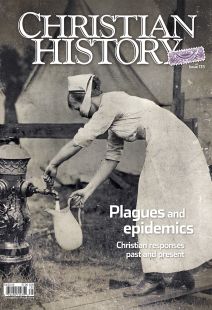Remedies from danger

[Artist unknown. Rev. Cotton Mather Using His Powerful Influence to Overcome the Prejudice Against Inoculation for Smallpox in Boston, 1721. 1926. Boston. Bronze. WBC ART / Alamy Stock Photo]
In the summer and fall of 1721, smallpox ravaged Boston. It continued into the following year, handing town leaders a major public health crisis with high infection and mortality rates. Yet its most lasting significance came from the role played by two figures: Rev. Cotton Mather (1663–1728) and his African slave Onesimus, whom he had been given 15 years earlier.
Praying for mercy
The epidemic began when the British naval vessel HMS Seahorse arrived on April 22 with a number of infected crew. Word of the sailors’ illness prompted officials to quarantine the crew and order Boston’s streets swept of dirt. These initial measures failed to contain the virus; over the next two months, it worked its way through the population, prompting the flight of hundreds of town residents into the countryside and the cancellation of public activities.
Massachusetts Bay governor Samuel Shute proclaimed a day of humiliation in late June for the colonists to fast and pray for God’s mercy and protection. At the end of the summer, the General Court moved to Cambridge to prevent delegates from carrying the disease from Boston back to their towns. By October Boston’s ministers reduced Sunday worship to one sermon to reduce frequency of contact among churchgoers. By then nearly a quarter of the town’s residents had contracted the disease. Young and old alike died, some 400 in the month of October alone.
Boston had experienced smallpox outbreaks before; the 1702–1703 event had killed over 300, and six other outbreaks had occurred in the 1600s. This had led the colony to prepare itself for future events. In 1701 Massachusetts enacted the first smallpox prevention measure, giving the government authority to requisition houses for patient isolation.
In addition colony officials built a quarantine house on Spectacle Island for crews of inbound ships, and, just prior to the 1721 outbreak, the town of Boston had constructed a quarantine hospital. Yet Boston’s preventative measures and its policies of public hygiene and social isolation seem to have failed to stop the 1721 event from infecting half the population and killing over 800 before ending the following year.
However, the 1721–1722 outbreak proved to be different in one important respect: Mather’s public campaign in support of inoculation. Mather had contracted smallpox in 1678, and three of his children were infected in the 1702 outbreak. His household included an African slave, Onesimus, referred to as a member of the “Garamantee” tribe in Mather’s writings. (This archaic term was used to describe Saharan people from present-day Libya and Sudan.)
Yes and no
In 1707 Mather asked Onesimus if he ever had smallpox and his answer was “Both, Yes, and No.” Onesimus gave Mather an account of having “undergone an Operation which had given him something of the Small-Pox, & would forever praeserve him from it.” In a letter in September 1721, Mather wrote:
There has been a wonderful practice lately used in several parts of the world, which indeed is not yet become common in our nation. I was first informed of it by a Garamantee servant of my own, long before I knew that any Europeans or Asiaticks had the last acquaintance with it. . . . My servant . . . shewed me the Scar of the Wound made for the operation; and said, That no person ever died of the small-pox, in their country, that had the courage to use it.
He added (in words that would later be criticized):
I have since met with a considerable Number of these Africans, who all agree in one story; That in their country grandy-many dy of the small-pox: But now they learn this way: people take juice of small-pox and cutty-skin and put in a Drop: then by ’nd by a little sicky sicky: then very few little things like small-pox; and nobody dy of it; and nobody have small-pox any more. . . . A merciful God has taught them an Infallible preservative. ’Tis a common practice, and is attended with a constant success.
These accounts agreed with articles Mather had been reading in the Philosophical Transactions since 1714—which described the success of Dr. Emanuel Timonius’s inoculation procedures among European expatriates in Constantinople.
Intentional infection
Bouyed by these testimonies, in the summer of 1721, Mather encouraged Boston’s physicians to take up inoculation. They declined, but Zabdiel Boylston (1679–1766), a local surgeon and apothecary, successfully inoculated his son and two members of an enslaved African family in his household. These were the first three known inoculations in the New World; the public’s reaction was swift and almost entirely hostile.
Critics assailed Boylston for intentionally infecting patients with no known immunity—essentially, they felt, attempting murder. Rumors circulated that Boylston was the target of a lynch mob. Mather became implicated and in November, an unidentified assailant threw a bomb into his house with an attached note that read: “cotton mather, You Dog, Dam you; I’l inoculate you with this, with a pox to you.” Providentially, Mather noted, the bomb didn’t explode.
Learned critics like William Douglass, a physician educated in Edinburgh, Leyden, Paris, and Utrecht, believed the procedure to be unproven. He expressed racist contempt: “‘The more blundering and Negroish they tell their Story, it is the more credible says C[otton] M[ather].; a paradox in Nature; for all they say true or false is after the same manner.”
Through the fall and winter, Mather and Boylston grew confident in the experiment, though, and eventually inoculated hundreds of Boston’s residents. Only 6 of the 287 people (2 percent) who developed smallpox via inoculation died. This compares with 844 deaths among the 5,700-plus (15 percent) who contracted the disease the natural way. These results, coupled with his escape from assassination, encouraged Mather to go on the offensive against inoculation’s critics.
But many, if not most, Christians believed that God had allowed smallpox to spread among the people as a punishment for their sins. As such, they argued, inoculation constituted direct human interference with the will of God. In pamphlets and letters, Mather flatly rejected this view of God’s providential design. He believed advances in knowledge were divine gifts and reason must play a role in crafting human responses to natural perils. To Mather, God may have sent Indians to attack the Puritan settlements as a rod of chastisement, but God also gave the settlers muskets, gunpowder, and lead to protect themselves. He wrote, “Almighty God, in his great Mercy to Mankind, has taught us a Remedy to be used, when the Dangers of the Small Pox distress us.”
A strange possession
The Boston smallpox epidemic of 1721–1722 confirmed to Mather that science and medicine were given by God to benefit humankind, and that reason, logic, and yes, faith—the kind demonstrated by Dr. Boylston when he inoculated his household—were necessary to grasp God’s intentions amid widespread infectious disease.
Furthermore Mather was convinced that Satan had taken a “Strange Possession of the People” who stood in opposition, or why else would they reject a procedure he thought was so clearly intended by God for our benefit? To his way of thinking, even the Bible testified to the wisdom and goodness of proven medicines and medical procedures. He indicated in a letter to James Jurin in 1723, “Certainly our sacred Bible will not be a dispensatory that shall determine anything in the matter of the medicine to be unlawful.”
Mather believed that Scripture, reason, and experience testified to God’s intention that inoculation be widely adopted. This paved the way for an entirely new approach to public health. Rather than merely react to outbreaks with quarantines and increased vigilance, inoculation provided a means of prevention, perhaps even complete eradication. Over time inoculation and vaccination became one of the key pillars of modern public health systems; required by law, upheld by rulings like Jacobsen v. Massachusetts (1905), and embraced by the overwhelming majority of citizens. CH
By Jeffrey B. Webb
[Christian History originally published this article in Christian History Issue #135 in 2020]
Jeffrey B. Webb is professor of American history at Huntington University.Next articles
Isolation, blessings, and questions
Readers describe their experiences of being faithful to Christ in the time of COVID-19. These reflections were written in March and April 2020.
ReadersPlagues and epidemics: Recommended resources 135
We searched through past CH issues and current academic bibliographies to bring you this list of new and classic books for understanding plague and Christian responses
The editorsSupport us
Christian History Institute (CHI) is a non-profit Pennsylvania corporation founded in 1982. Your donations support the continuation of this ministry
Donate




